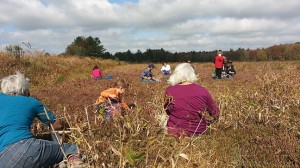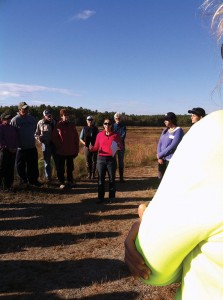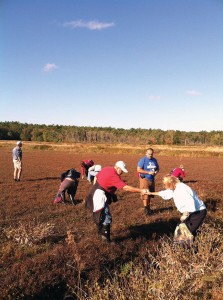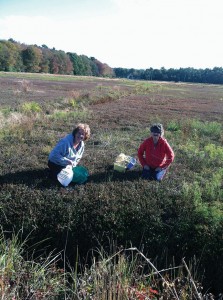On a picture-perfect October Saturday morning, Sara DaSilva Quintal, Restoration Ecologist with the Buzzards Bay Coalition, stood before a group of approximately 50 people who had come out to harvest cranberries. The coalition had put out an invitation to come to the now protected retired bogs formally owned by Decas Cranberry Company and harvest berries.
“These bogs were a high target for preservation due to their proximity to the watershed region,” DaSilva Quintal said. She said that the USDA had worked in partnership with the owner and the Coalition to secure the 60-acre parcel in the continuing effort to protect the aquifer. Noting the diversity of wildlife and plant life in the immediate area, she told the group that the beauty of the open spaces are now shared with the public for recreational activities. Beyond harvesting in the fall, there are walking and cycling trails, picnicking, bird watching and wild life observation, wildflowers, and the silence of nature to enjoy.
Many of us look forward to this time of the year and revel in all things associated with the harvest season. Canning and jarring the local bounty isn’t lost on us, the hearty New Englanders. Applesauce, pickles, green beans, peaches, blueberries, grapes, tomatoes, and so much more become captives in bottles and jars we cherish when the snow drifts pile against the front door. One fruit above all others has a deeper historical significance to this area: the mighty cranberry.
The Cape Cod Cranberry Growers Association website (www.cranberries.org) states: “The cranberry, along with the blueberry and Concord grape, is one of North America’s three native fruits that are commercially grown. Cranberries were first used by Native Americans, who discovered the wild berry’s versatility as a food, fabric dye, and healing agent.
“The name ‘cranberry’ derives from the Pilgrim name for the fruit, ‘craneberry,’ so called because the small, pink blossoms that appear in the spring resemble the head and bill of a Sandhill crane. European settlers adopted the Native American uses for the fruit and found the berry a valuable bartering tool.
“American whalers and mariners carried cranberries on their voyages to prevent scurvy. In 1816, Captain Henry Hall became the first to successfully cultivate cranberries. By 1871, the first association of cranberry growers in the United States had formed.”
When I look back in my own family history, there I find the cranberry. My maternal grandmother and great grandmother “screened” cranberries. My maternal grandfather would jump in a bog and pick berries on days when shore fishing wasn’t an option. The cranberry industry you could say is in my blood. Yet for my son the juice runs even deeper.
My son’s paternal family from grandfather to father, from uncle and aunt to cousins, all worked long hours seven days a week when the cranberry harvest was in full swing. In those days, most bogs were “dry” picked. It was exhausting, labor-intensive work. Dry picking required crews of people operating small machines that were similar to small rotor-tillers. In staggered lines, the crew members walked behind the picking machines making sure that all of the berries were removed from the vines. Once the box was full, the worker quickly removed it, replacing it with an empty one without stopping the forward motion, hour after hour, day after day, until the harvest was in. Fresh fruit cranberries would then be taken to a “screen” house where the berries would pass along on conveyer belts and the “screeners” would deftly remove the less than perfect specimens, leaves, and vines. These berries were then processed into either juice or sauce.
Also from The Cape Cod Cranberry Growers website, we find the details for the dry picking process: “This traditional method of harvesting now represents about 10% of the Massachusetts cranberry harvest. Even though fresh fruit represents a small fraction of the total harvested crop, it nevertheless is an important aspect of the cranberry industry and for many growers, a way of life. In order to pick the fresh fruit, the vines must be completely dry. Even a slight shower the night before, heavy dew, or damp conditions from a frost is enough to delay harvest until the conditions improve on the bog.
“The marketing of cranberry products hadn’t reached the zenith as it is today with blended juices, flavored dried berries, berries in cereal, berries in cake and bread mixes, cookies, covering supermarket shelves. Nor had the marketing machine reached beyond the continental U.S. The cranberry industry has done a remarkable job promoting the health benefits of the mighty cranberry not only domestically but globally as well. In 2011 33% of the total U.S. production was exported. European and Asian markets have fallen in love with the mighty cranberry.
“Today most bogs are wet picked. The bogs are flooded and machines beat the vines causing the berries to float to the top where they are rounded up and conveyed into waiting trucks. Wet picking doesn’t require anywhere near the amount of human power that dry picking does. And as the demand for processed cranberry products has increased the demand for dry picked berries has declined. Dry picked berries are the fresh fruit you’ll find in the market seasonally for cranberry bread, homemade sauce, craft projects or, your own fancy holiday fare.”
In 1973, I was young, strong, and looking for employment. It was a time when economic conditions were difficult. White-collar positions in this area were few and far between. I cast about willing to take any type of work to bring in a few dollars. An acquaintance of mine was a crew foreman for Decas Cranberries. He offered me a job picking. I didn’t hesitate, even though I didn’t have a clue what I had signed on for or how it would change my opinion of agricultural work.
Manual labor requires one to put the ego on the shelf and put the body in motion, the brain on hold. Yet there was a type of soul-satisfying meditation when you spend the entire day walking behind a machine that combs cranberries off the vine. You pace yourself and separate your thinking from your body’s repetitive motions, your thoughts can wander and you have time to solve your problems. At least that was my experience. That experience of being out in the open, sitting on an overturned cranberry box waiting for the bog to dry sufficiently for picking made me appreciate fully the men and women who work the fields. I felt closer to my ancestors and felt compassion for the struggles they went through to provide for their children. I felt more connected from having been a bog worker.
Today, about 20% of the total U.S. cranberry harvest comes for the greater Buzzards Bay area. Other regions where cranberries are cultivated commercially are New Jersey, Wisconsin, and the Pacific Northwest. Such large-scale production is not without its impact on the environment.
Commercially cultivated cranberries require vast amounts of fresh water. Fertilizers are used, which causes nitrogen to leach into the ground water. In Mattapoisett, the retiring of bogs near the watershed is of paramount importance.
On this day, many were enjoying that very activity. Mark Kearins of Norfolk has a summer home here and was out for a morning to get fresh air and to learn more about the work of the Coalition. Carol Adler and her friend Pam talked about how much fun they had as children ice skating on frozen bogs and the glory of the morning at hand. Erin Riordan of Marion gathered her fair share with a huge grin on her face. Andrea Buckley and her sister-in-law Karin Kingsland rode their bikes from home and were looking forward to making Thanksgiving goodies with their red bounty. May Wooding and Aimee Mack of Bristol, R.I., had heard about the outing from the Coalition’s mailing, they couldn’t wait to get into the bogs.
Colleen Hamilton and Grace Mullen-Thompson are Commonwealth Corps interns working presently with the coalition. They guided groups further into the bogs seeking good patches from which the rubies could be collected.
DaSilva Quintal said that eventually the bogs would return to woodlands. As I looked out over the acreage, I wondered if one day someone would be giving a talk on the preservation and say, “People used to come here and pick the wild cranberries.”
By Marilou Newell




